
Chinese Journal of Applied Chemistry ›› 2024, Vol. 41 ›› Issue (6): 783-799.DOI: 10.19894/j.issn.1000-0518.230400
• Review • Previous Articles
Research Progress in OLEDs Emissive Materials Based on Cu(Ⅰ) Complexes
Guan-Zhong WANG1,4, Shi-Ping SONG2, Hong-Zhen PENG2, Yu ZHANG3, Ying ZHU2, Jing CHEN2( )
)
- 1.Division of Physical Biology,CAS Key Laboratory of Interfacial Physics and Technology,Shanghai Institute of Applied Physics,Chinese Academy of Sciences,Shanghai 201800,China
2.Institute of Materiobiology,Department of Chemistry,College of Sciences,Shanghai University,Shanghai 200444,China
3.Shanghai Synchrotron Radiation Facility,Shanghai Advanced Research Institute,Chinese Academy of Sciences,Shanghai 201210,China
4.University of Chinese Academy of Sciences,Beijing 100049,China
-
Received:2023-12-29Accepted:2024-04-21Published:2024-06-01Online:2024-07-09 -
Contact:Jing CHEN -
About author:chenjing929@shu.edu.cn
-
Supported by:the National Key R&D Program of China(2023YFC3404200);the National Natural Science Foundation of China(21974147)
CLC Number:
Cite this article
Guan-Zhong WANG, Shi-Ping SONG, Hong-Zhen PENG, Yu ZHANG, Ying ZHU, Jing CHEN. Research Progress in OLEDs Emissive Materials Based on Cu(Ⅰ) Complexes[J]. Chinese Journal of Applied Chemistry, 2024, 41(6): 783-799.
share this article
Add to citation manager EndNote|Ris|BibTeX
URL: http://yyhx.ciac.jl.cn/EN/10.19894/j.issn.1000-0518.230400
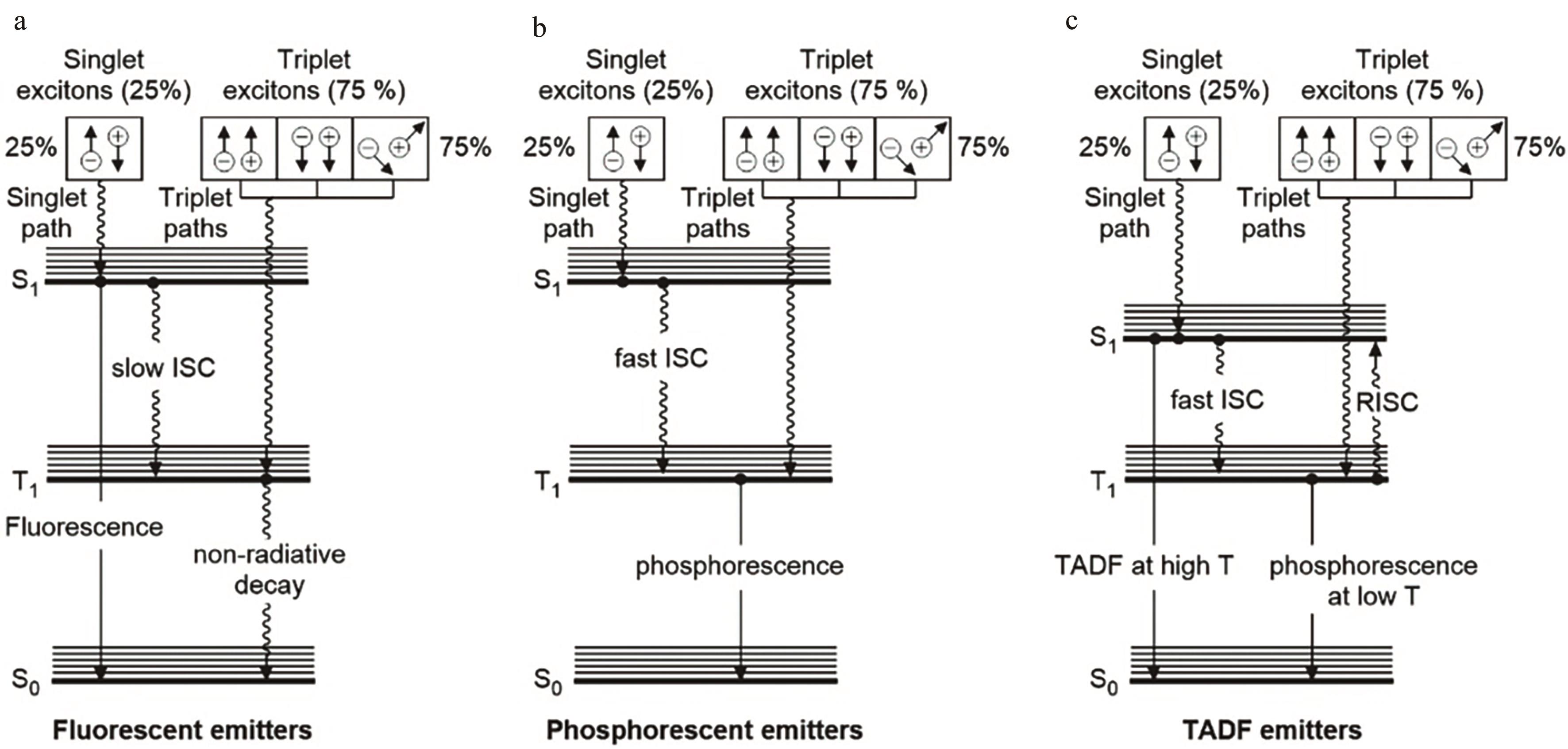
Fig.1 Schematic diagram to illustrate the molecular mechanism of (a) fluorescent, (b) phosphorescent and (c) thermally activated delayed fluorescence[3]
| Ligands | ΔEST/eV | Emissions/nm a | PLQYs/% a | τ/μs a | EQE/% | Ref. |
|---|---|---|---|---|---|---|
| POP,ECAF | 0.09 | 550 | 22.4 | 5.7 | 14.81 | [ |
| POP,EHCAF | 0.09 | 549 | 18.5 | 5.7 | 11.17 | [ |
| POP,PCAF | 0.09 | 556 | 20.0 | 5.7 | 6.67 | [ |
| POP,DMAC-PyPI | 0.11 | 534 | 62 | 21.4 | - | [ |
| Xantphos,DMAC-PyPI | 0.08 | 533 | 71 | 24.1 | 5.91 | [ |
| POP,PXZ-PyPI | 0.07 | 565 | 48 | 5.8 | 7.96 | [ |
| Xantphos, PXZ-PyPI | 0.05 | 564 | 42 | 4.3 | - | [ |
| Cbz,BINAP | 0.08 | 564 | 22 | 5.0 (91), 46.0 (9) | - | [ |
| Cbz tBu,BINAP | 0.06 | 549 | 25 | 19.2 (74), 62.6 (26) | - | [ |
| POP,PNNA | 0.12 | 493 | 60.9 | 145 | 5.83 | [ |
| PNNA,Xantphos | 0.12 | 475 | 40.7 | 51 | 7.42 | [ |
| PPh3,pptz | 0.09 | 490 | 89.87 | 23.6 | - | [ |
Table 1 The optical properties of mononuclear Cu(Ⅰ) complexes with N and P coordination atoms
| Ligands | ΔEST/eV | Emissions/nm a | PLQYs/% a | τ/μs a | EQE/% | Ref. |
|---|---|---|---|---|---|---|
| POP,ECAF | 0.09 | 550 | 22.4 | 5.7 | 14.81 | [ |
| POP,EHCAF | 0.09 | 549 | 18.5 | 5.7 | 11.17 | [ |
| POP,PCAF | 0.09 | 556 | 20.0 | 5.7 | 6.67 | [ |
| POP,DMAC-PyPI | 0.11 | 534 | 62 | 21.4 | - | [ |
| Xantphos,DMAC-PyPI | 0.08 | 533 | 71 | 24.1 | 5.91 | [ |
| POP,PXZ-PyPI | 0.07 | 565 | 48 | 5.8 | 7.96 | [ |
| Xantphos, PXZ-PyPI | 0.05 | 564 | 42 | 4.3 | - | [ |
| Cbz,BINAP | 0.08 | 564 | 22 | 5.0 (91), 46.0 (9) | - | [ |
| Cbz tBu,BINAP | 0.06 | 549 | 25 | 19.2 (74), 62.6 (26) | - | [ |
| POP,PNNA | 0.12 | 493 | 60.9 | 145 | 5.83 | [ |
| PNNA,Xantphos | 0.12 | 475 | 40.7 | 51 | 7.42 | [ |
| PPh3,pptz | 0.09 | 490 | 89.87 | 23.6 | - | [ |
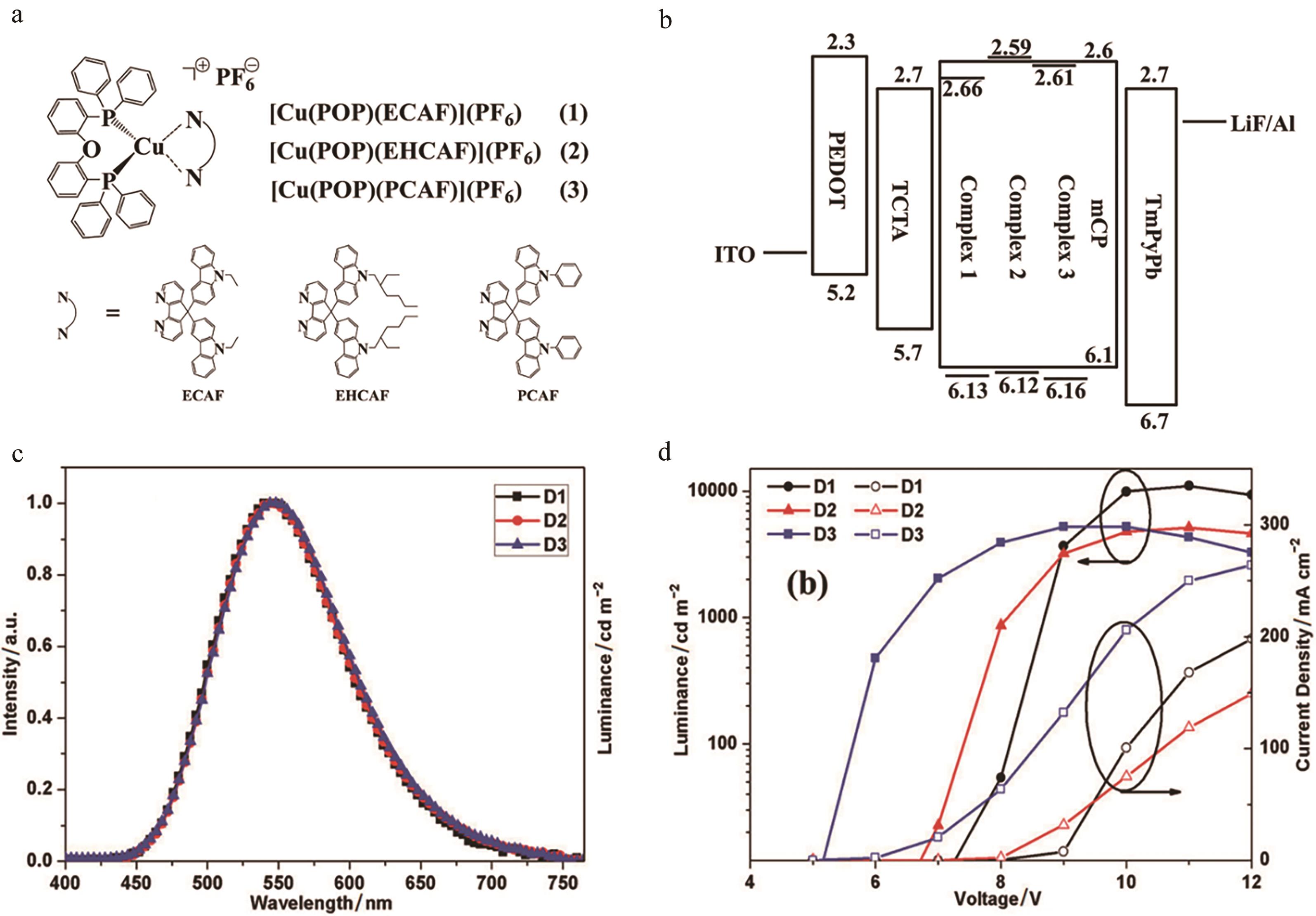
Fig.2 (a) Structures of complexes; (b) Device architecture of OLEDs; (c) Normalized EL spectra of OLEDs; (d) Luminance and current density versus voltage for the OLEDs devices[28]
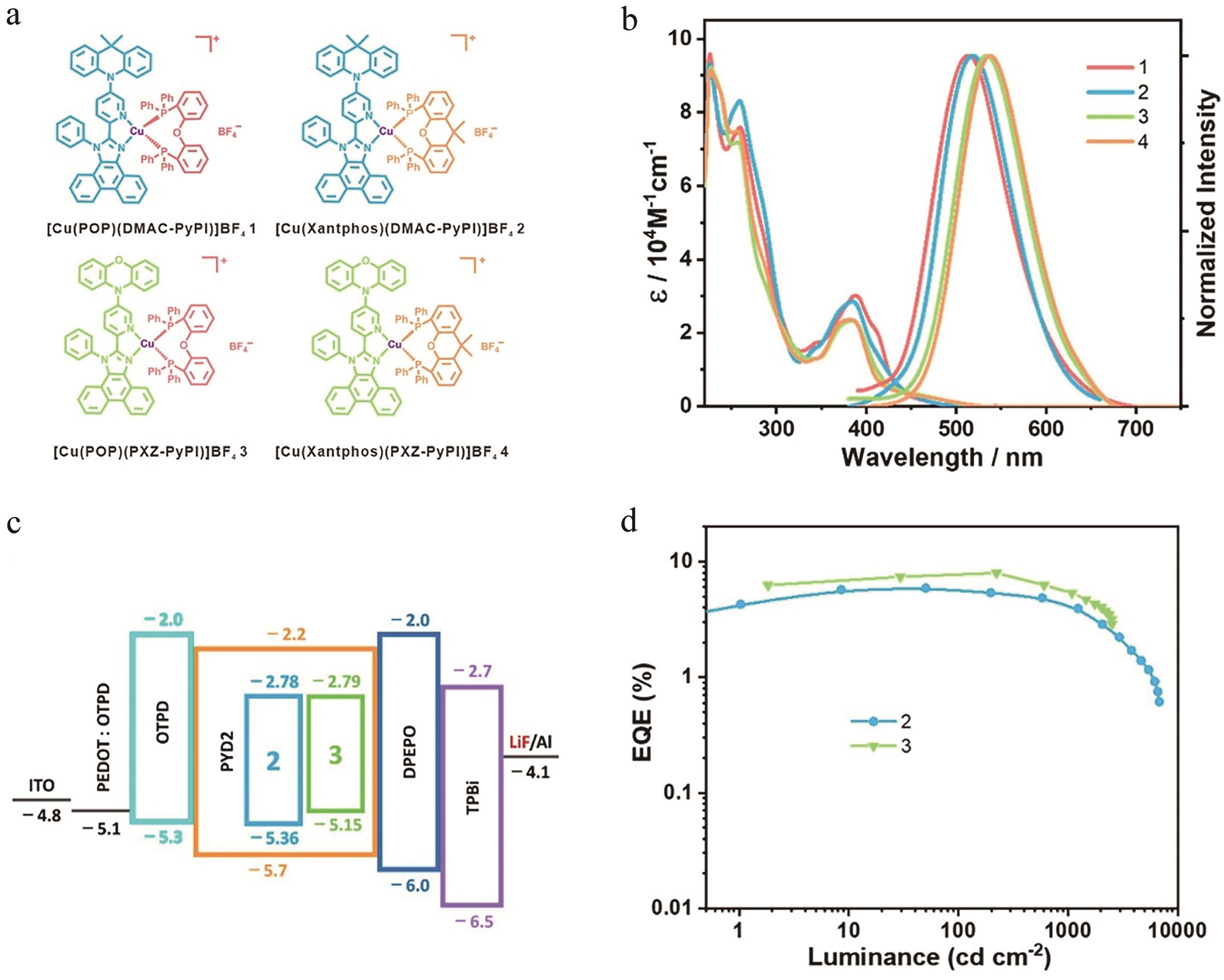
Fig.3 (a) Structures of complexes; (b) UV-Vis absorption and emission spectra of complexes in CH2Cl2 solution; (c) Device architecture of OLEDs; (d) EQE-luminance characteristics of OLEDs[29]

Fig.4 (a) Structures of Cu(CbzR)[(S/R)-BINAP]; (b) Temperature dependence of the radiative lifetimes of complexes in the ground solid state, and state diagrams visualizing the TADF processes; (c) CD (dashed lines) and CPL (solid lines) spectra of (S/R)-1 and (S/R)-2 in THF; (d) General OLEDs stack architecture and EL spectra[30]
| ligands | ΔEST/eV | Emissions/nm | PLQYs/% | τ/μs a | EQE/% | Ref. |
|---|---|---|---|---|---|---|
| POP,pytzph | 0.09 | 509 | 43 | 5.5 | 7.6 | [ |
| POP,pytzphcf | 0.13 | 519 | 29 | 16.0 | 6.2 | [ |
| POP,pytzphcz | 0.09 | 503 | 79 | 5.5 | 8.3 | [ |
| DPEPhos,TzTz | - | 712 | 1 | 3.1 | 0.32 | [ |
| XantPhos,TzTz | - | 705 | 1 | 3.2 | 0.17 | [ |
| Tpbz,pz4B | 0.07 | 580 | 7 | 20.5 | - | [ |
| Tpbz,pz2BH2 | 0.08 | 569 | 28 | 11.9 | - | [ |
| Tpbz,tz2BH2 | 0.04 | 540 | 45 | 7.4 | - | [ |
| PymPPh2,MeCN | 0.09 | 515 | 47 | 27.0 | - | [ |
| PymPPh2 | - | 525 | 15 | 22 | - | [ |
| PymPPh2,PhCN | 0.06 | 550 | 65 | 9.6 | - | [ |
Table 2 The optical properties of binuclear copper complexes with N and P coordination atoms
| ligands | ΔEST/eV | Emissions/nm | PLQYs/% | τ/μs a | EQE/% | Ref. |
|---|---|---|---|---|---|---|
| POP,pytzph | 0.09 | 509 | 43 | 5.5 | 7.6 | [ |
| POP,pytzphcf | 0.13 | 519 | 29 | 16.0 | 6.2 | [ |
| POP,pytzphcz | 0.09 | 503 | 79 | 5.5 | 8.3 | [ |
| DPEPhos,TzTz | - | 712 | 1 | 3.1 | 0.32 | [ |
| XantPhos,TzTz | - | 705 | 1 | 3.2 | 0.17 | [ |
| Tpbz,pz4B | 0.07 | 580 | 7 | 20.5 | - | [ |
| Tpbz,pz2BH2 | 0.08 | 569 | 28 | 11.9 | - | [ |
| Tpbz,tz2BH2 | 0.04 | 540 | 45 | 7.4 | - | [ |
| PymPPh2,MeCN | 0.09 | 515 | 47 | 27.0 | - | [ |
| PymPPh2 | - | 525 | 15 | 22 | - | [ |
| PymPPh2,PhCN | 0.06 | 550 | 65 | 9.6 | - | [ |
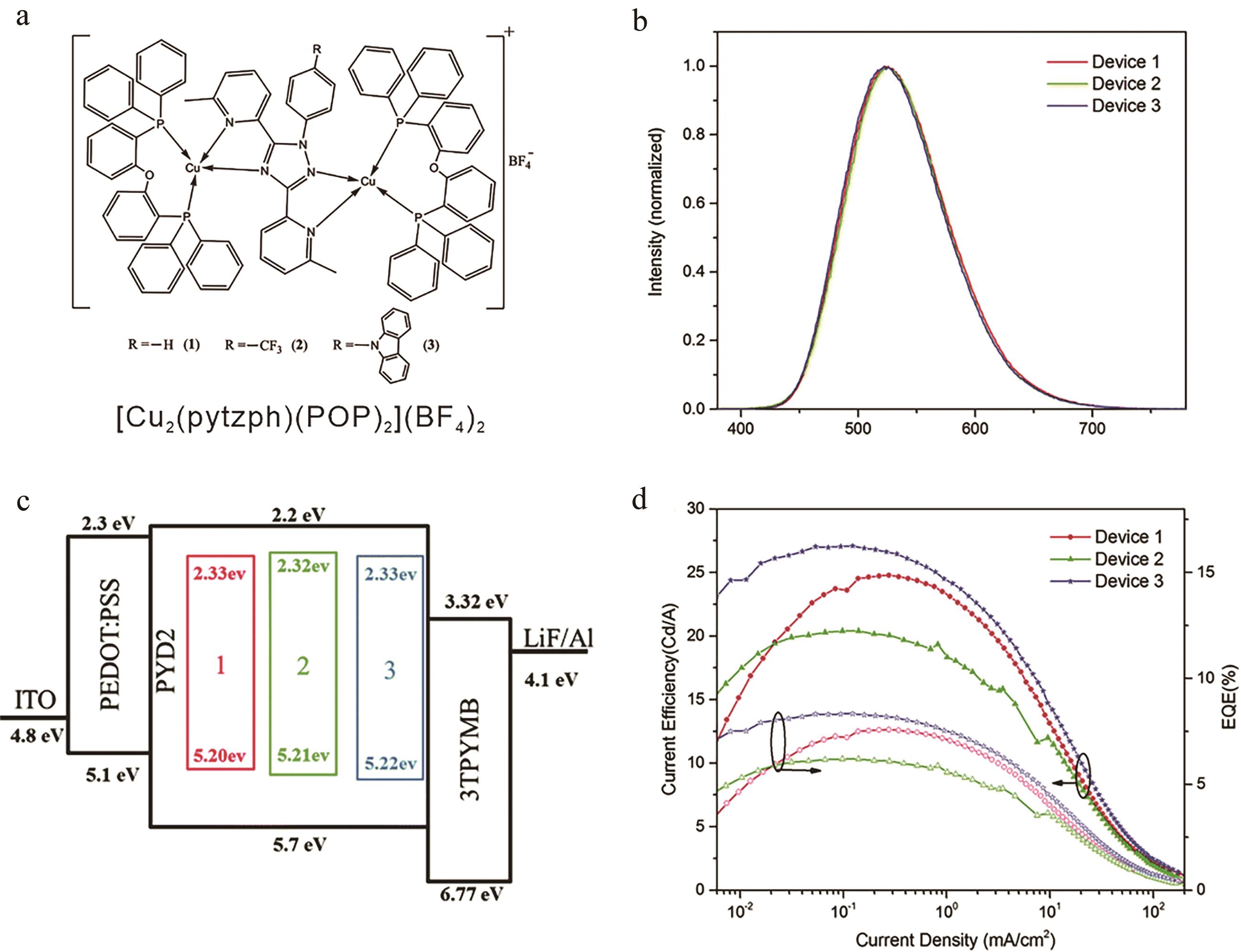
Fig. 5 (a) Structures of [Cu2(pytzph)(POP)2](BF4)2; (b) Normalized EL spectra of OLEDs; (c) Device architecture of OLEDs; (d) Current efficiency and EQE versus current density for the OLEDs devices[34]
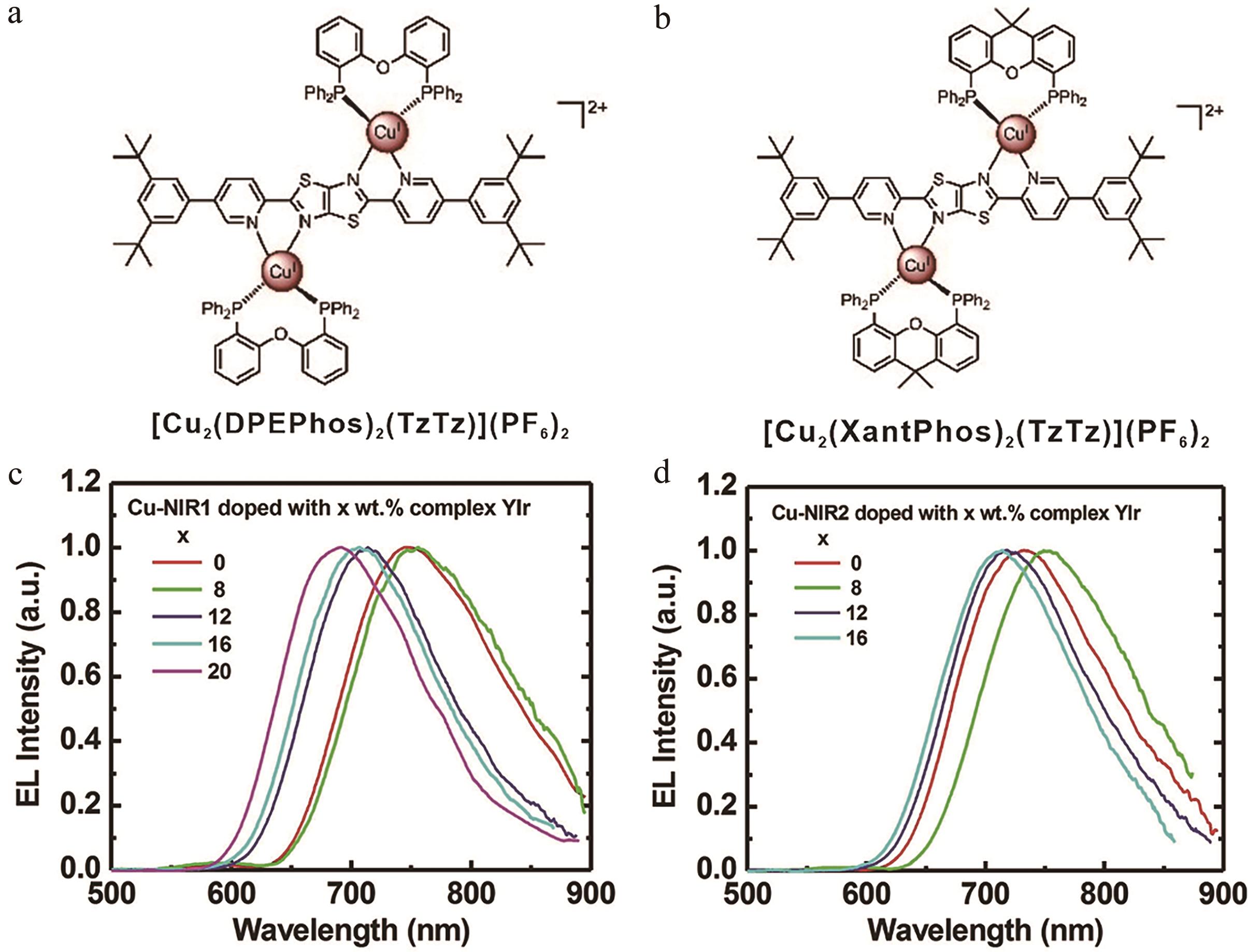
Fig.6 (a) Structures of [Cu2(DPEPhos)2(TzTz)]2+; (b) Structures of [Cu2(XantPhos)2(TzTz)]2+; (c) Normalized EL spectra of OLEDs based on [Cu2(DPEPhos)2(TzTz)]2+; (d) Normalized EL spectra of OLEDs based on [Cu2(XantPhos)2(TzTz)]2+[36]
| Ligands | ΔEST/eV | Emissions/nm | PLQYs/% | τ/μs a | EQE/% | Ref. |
|---|---|---|---|---|---|---|
| dppt1,I | 0.07 | 487 | 69 | 9.46 | 7.44 | [ |
| dppt2,I | 0.05 | 483 | 86 | 7.62 | 14.50 | [ |
| TTPP,Cl | 0.01 | 530 | 76 | 19 | 9.6 | [ |
| TTPP,Br | 0.04 | 523 | 79 | 16 | 12.4 | [ |
| TTPP,I | 0.05 | 521 | 83 | 11 | 16.3 | [ |
| DBFDP,I | 0.16 | 491 | 5 | 2 | 0.73 | [ |
| PPh3,HPBI,I | - | 581 | 38 | 8.2 | 3.4 | [ |
| PPh3,MOPBI,I | - | 557 | 34 | 22.6 | - | [ |
| PPh3,POPBI,I | - | 382 | 30 | 15.8 | - | [ |
| dpmb,I | 0.12 | 498 | 32 | 2.5 | 10.1 | [ |
| dpmb,Br | 0.12 | 511 | 28 | 12.5 | 7.3 | [ |
| dpmb,Cl | 0.14 | 527 | 29 | 4.8 | 8.3 | [ |
Table 3 The optical properties of Cu(I) complexes with N,P,X(halogen) coordination atoms
| Ligands | ΔEST/eV | Emissions/nm | PLQYs/% | τ/μs a | EQE/% | Ref. |
|---|---|---|---|---|---|---|
| dppt1,I | 0.07 | 487 | 69 | 9.46 | 7.44 | [ |
| dppt2,I | 0.05 | 483 | 86 | 7.62 | 14.50 | [ |
| TTPP,Cl | 0.01 | 530 | 76 | 19 | 9.6 | [ |
| TTPP,Br | 0.04 | 523 | 79 | 16 | 12.4 | [ |
| TTPP,I | 0.05 | 521 | 83 | 11 | 16.3 | [ |
| DBFDP,I | 0.16 | 491 | 5 | 2 | 0.73 | [ |
| PPh3,HPBI,I | - | 581 | 38 | 8.2 | 3.4 | [ |
| PPh3,MOPBI,I | - | 557 | 34 | 22.6 | - | [ |
| PPh3,POPBI,I | - | 382 | 30 | 15.8 | - | [ |
| dpmb,I | 0.12 | 498 | 32 | 2.5 | 10.1 | [ |
| dpmb,Br | 0.12 | 511 | 28 | 12.5 | 7.3 | [ |
| dpmb,Cl | 0.14 | 527 | 29 | 4.8 | 8.3 | [ |
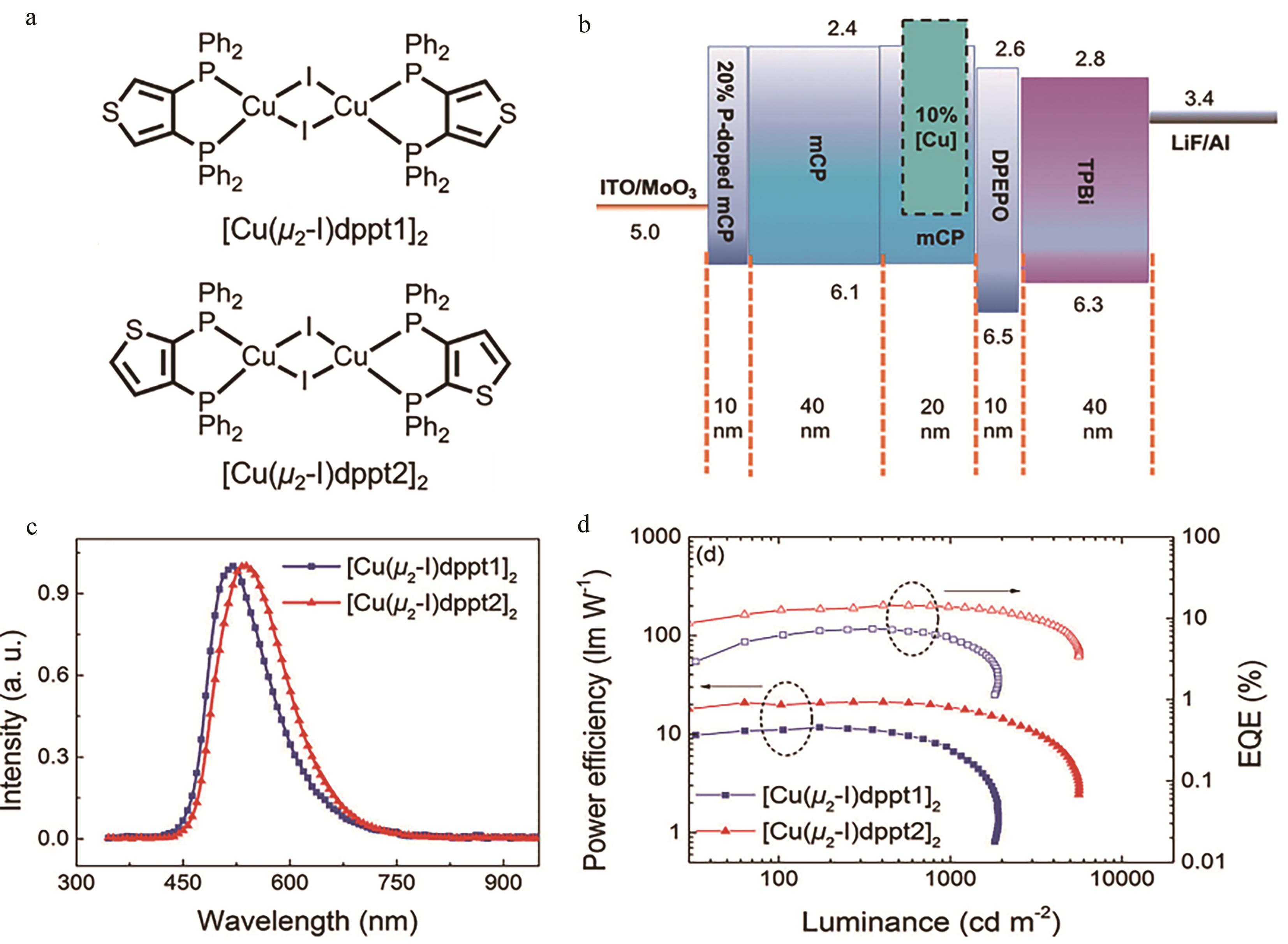
Fig.7 (a) Structures of [Cu(μ2-I)dppt1]2 and [Cu(μ2-I)dppt2]2; (b) Device architecture of OLEDs; (c) EL spectra of both devices at 12 V device architecture of OLEDs; (d) PE-L-EQE characteristics of both devices[45]
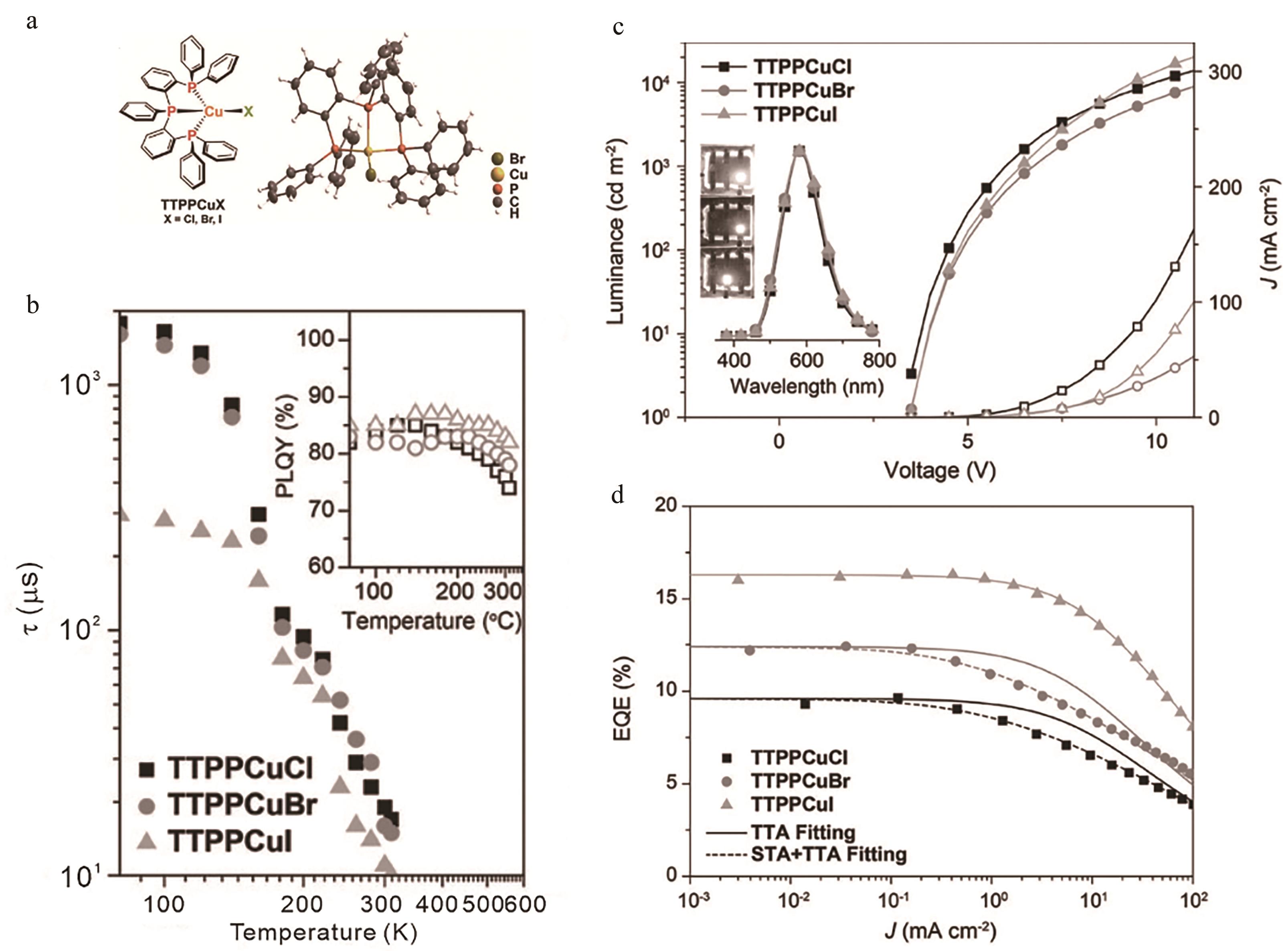
Fig.8 (a) Chemical structure of TTPPCuX (X=Cl, Br, I) and single-crystal structure of TTPPCuBr; (b) Temperature dependence of emissive lifetime (τ) and PLQY for TTPPCuX; (c) Current density (J) (hollow)?-luminance (solid)-voltage curves, EL spectra at 1000 cd/m2 and device photos at 5 V (inset); (d) EQE-J correlations and the fitting curves according to TTA and STA+TTA models[48]
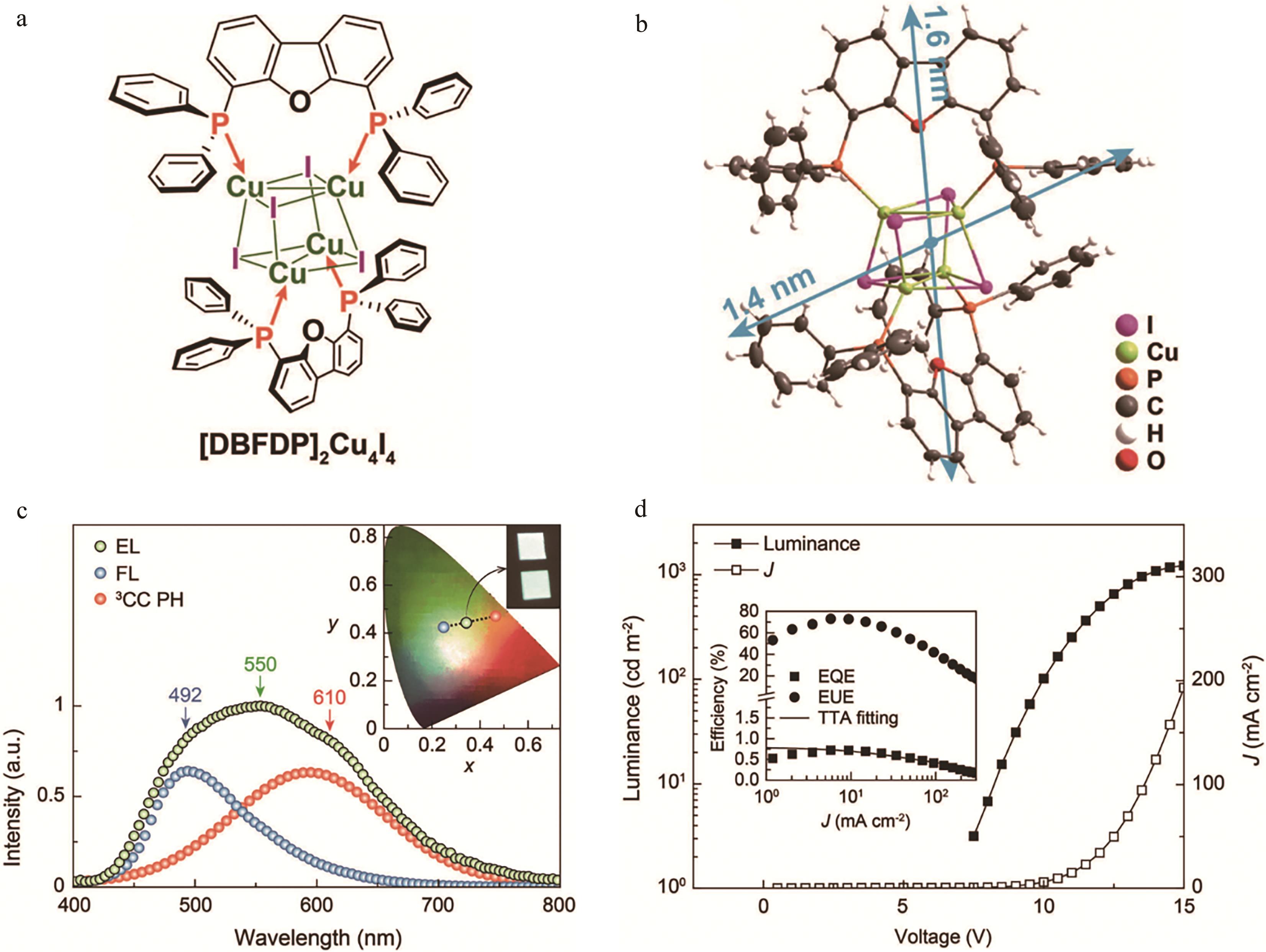
Fig.9 (a) Structures of [DBFDP]2Cu4I4; (b) Single-crystal structure and packing diagram of [DBFDP]2Cu4I4; (c) EL spectra, CIE coordinates and photographs (insets) of the OLEDs using [DBFDP]?2Cu4I4 as dopant; (d) Luminance-current density (J)-voltage relationship and EQE/EUE-J curves (inset)[49]
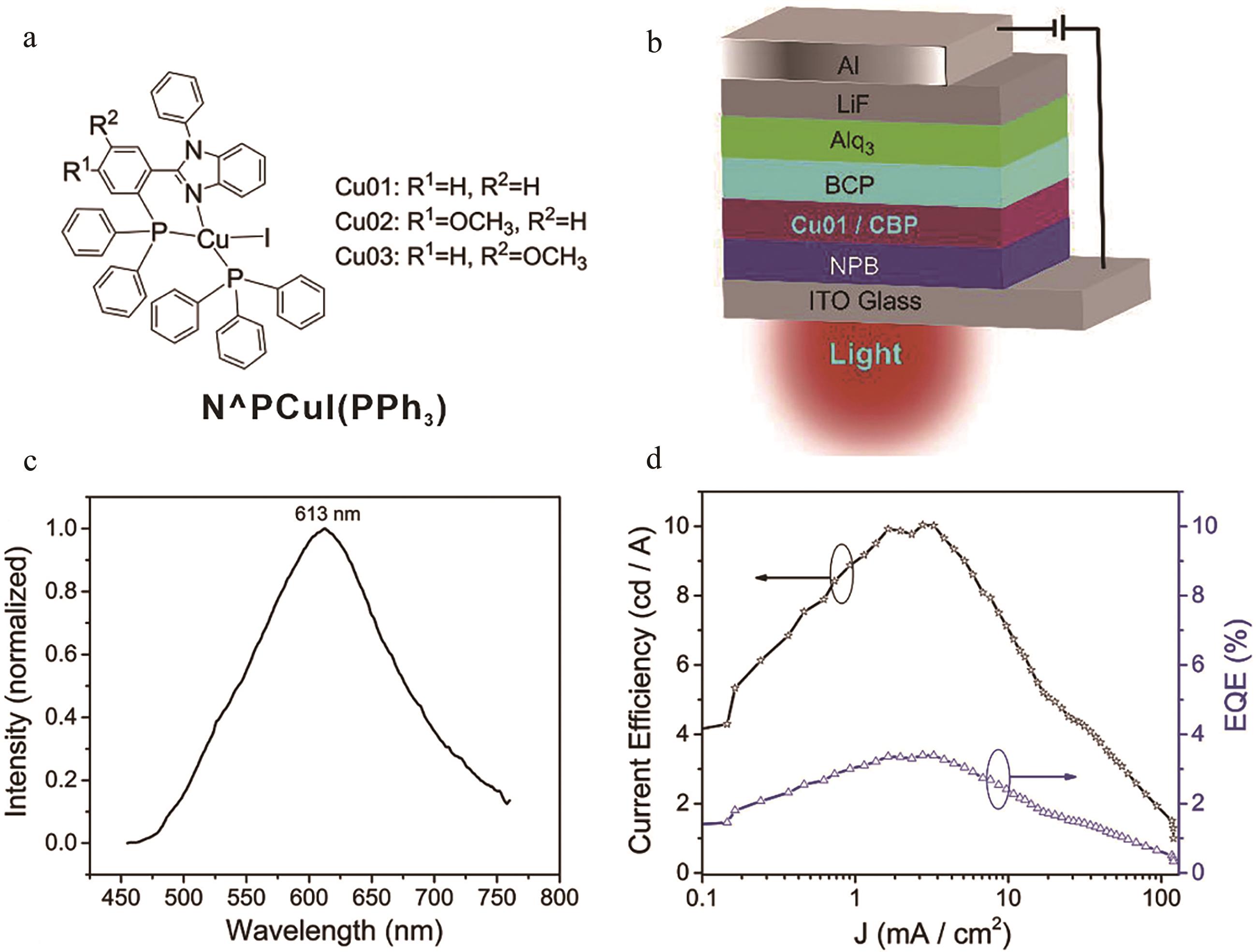
Fig.10 (a) Structures of N^PCuI(PPh3); (b) Device architecture of OLEDs; (c) Normalized EL spectra of OLEDs based on N^PCuI(PPh3); (d) Current efficiency-EQE-current density (J) relationship[51]
| Ligands | ΔEST/eV | Emissions/nm | PLQYs/% | τ/μs a | EQE/% | Ref. |
|---|---|---|---|---|---|---|
| CAAC,Cz | 0.01 | 474 | 65 | 1.3 | 9.0 | [ |
| MAC*,CzCN2 | - | 438 | 5 | 0.37(33%) 1.8(67%) | - | [ |
| MAC*,CzCN | - | 474 | 76 | 0.75 | - | [ |
| MAC*,Cz | 0.06 | 492 | 53 | 0.84 | 19.4 | [ |
| MAC*,DPAC | 0.05 | 609 | 24 | 0.42 | 21.1 | [ |
| MAC*,CzP | 0.06 | 559 | 40 | 0.4 | 15.2 | [ |
| MAC*,CNCzP | 0.11 | 518 | 48 | 2.58 (77%) 34.1 (23%) | 13.2 | [ |
| Ipr,dpa | 0.10 | 463 | 22 | 13 | - | [ |
| Ipr,dpym | 0.12 | 473 | 15 | 6 | - | [ |
| Ipr,dpyp | 0.10 | 474 | 73 | 14 | - | [ |
| Ipr,PPhpy2 | 0.10 | 503 | 86 | 13 | - | [ |
Table 4 The optical properties of Cu(Ⅰ) complexes with N, C coordination atoms
| Ligands | ΔEST/eV | Emissions/nm | PLQYs/% | τ/μs a | EQE/% | Ref. |
|---|---|---|---|---|---|---|
| CAAC,Cz | 0.01 | 474 | 65 | 1.3 | 9.0 | [ |
| MAC*,CzCN2 | - | 438 | 5 | 0.37(33%) 1.8(67%) | - | [ |
| MAC*,CzCN | - | 474 | 76 | 0.75 | - | [ |
| MAC*,Cz | 0.06 | 492 | 53 | 0.84 | 19.4 | [ |
| MAC*,DPAC | 0.05 | 609 | 24 | 0.42 | 21.1 | [ |
| MAC*,CzP | 0.06 | 559 | 40 | 0.4 | 15.2 | [ |
| MAC*,CNCzP | 0.11 | 518 | 48 | 2.58 (77%) 34.1 (23%) | 13.2 | [ |
| Ipr,dpa | 0.10 | 463 | 22 | 13 | - | [ |
| Ipr,dpym | 0.12 | 473 | 15 | 6 | - | [ |
| Ipr,dpyp | 0.10 | 474 | 73 | 14 | - | [ |
| Ipr,PPhpy2 | 0.10 | 503 | 86 | 13 | - | [ |
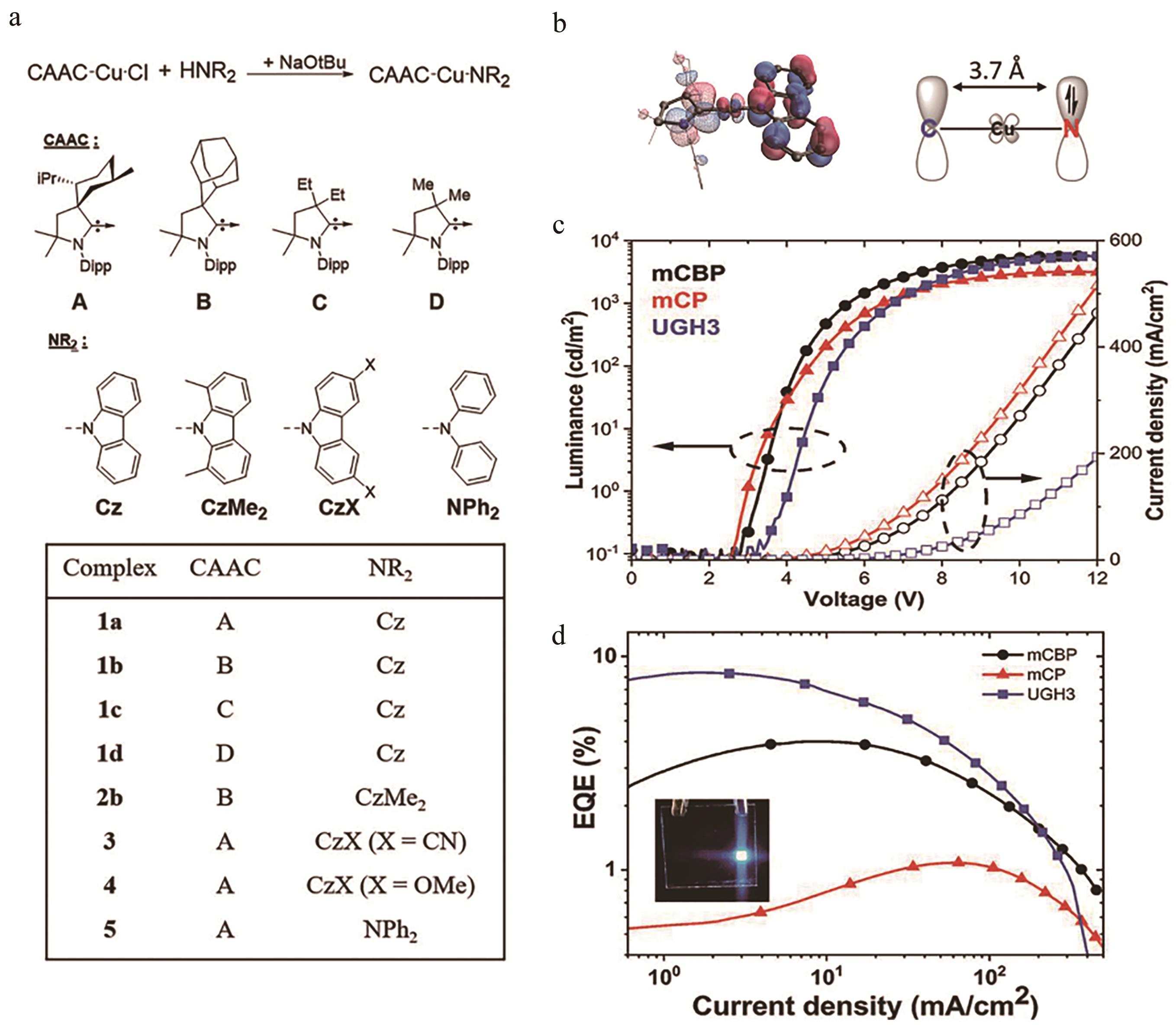
Fig.11 (a) Structures of CAAC-Cu-NR2; (b) HOMO (solid) and LUMO (mesh) surfaces of complex 1a; (c) Current (J)-voltage (V)-luminance (L) traces; (d) EQE traces of devices using different hosts (The inset is a photograph of a 1a-based device)[57]
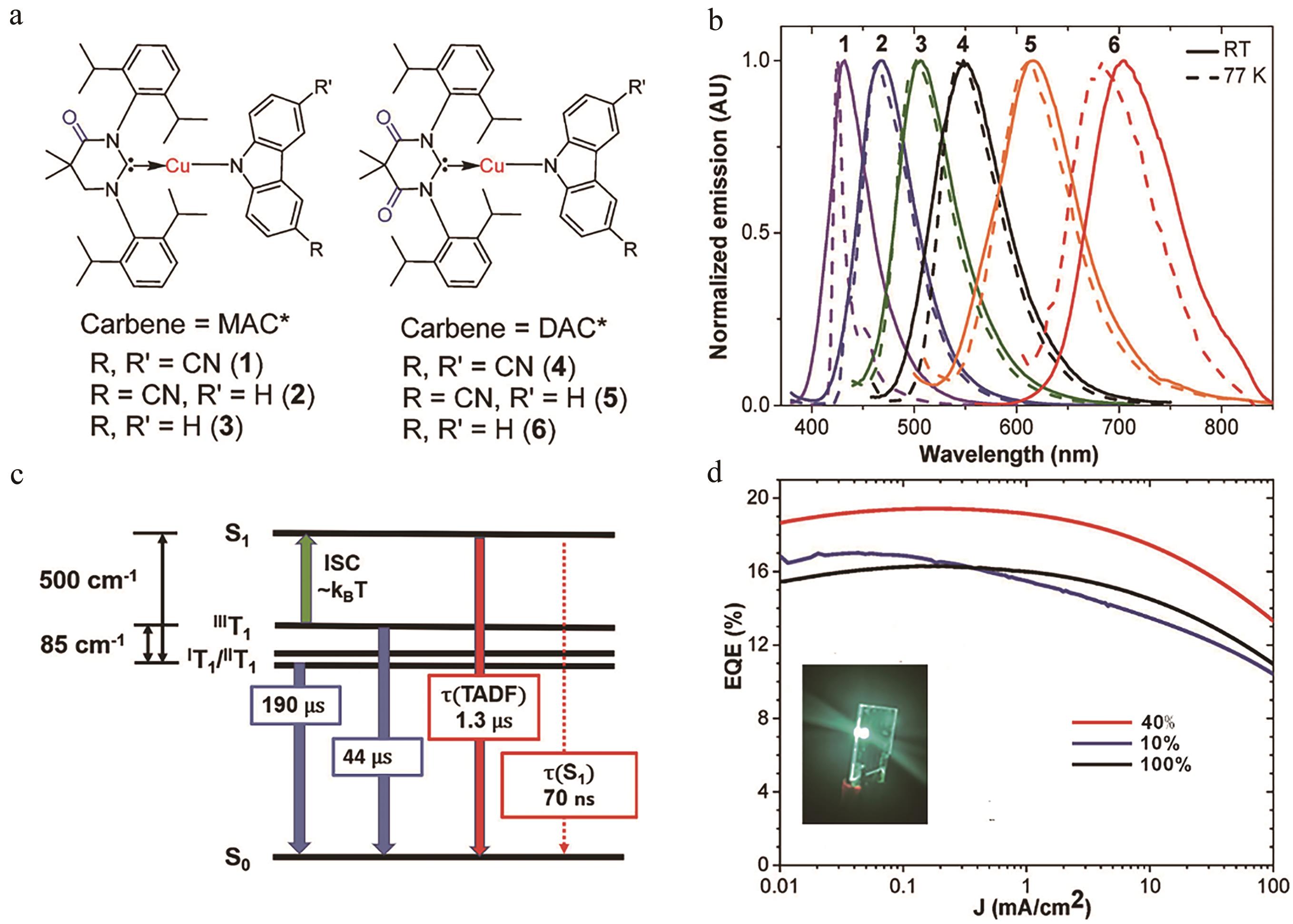
Fig.12 (a) Structures of (MAC*)Cu(CzRR') and (DAC*)Cu(CzRR'); (b) The emission spectra at room temperature (RT) and 77 K; (c) Energy level diagram for complex (MAC*)Cu(Cz); (d) External quantum efficiency. Inset: photograph of a (MAC*)Cu(Cz)-based device, doping mass concentrations of 3 are 10%, 40% and 100%[63]
| 1 | ZHANG N, QU L, HU H, et al. Sky blue and yellow cluster light-emitting diodes based on asymmetric Cu4I4 nanocubes[J]. Research,2022(2022): 0005. |
| 2 | TANG C, WVANSLYKE S. A organic electroluminescent diodes[J]. Appl Phys Lett,1987, 51(12): 913-915. |
| 3 | SANDOVAL-PAUKER C, SANTANDER-NELLI MDREYSE P. Thermally activated delayed fluorescence in luminescent cationic copper(Ⅰ) complexes[J]. RSC Adv, 2022, 12(17): 10653-10674. |
| 4 | FU Y, LIU H, YANG D, et al. Boosting external quantum efficiency to 38.6% of sky-blue delayed fluorescence molecules by optimizing horizontal dipole orientation[J]. Sci Adv,2021, 7(43): eabj2504. |
| 5 | UOYAMA H, GOUSHI K, SHIZU K, et al. Highly efficient organic light-emitting diodes from delayed fluorescence[J]. Nature,2012, 492(7428): 234-238. |
| 6 | MA Y G, ZHANG H Y, SHEN J C, et al. Electroluminescence from triplet metal-ligand charge-transfer excited state of transition metal complexes[J]. Synth Met,1998, 94(3): 245-248. |
| 7 | KIDO JIIZUMI Y. Fabrication of highly efficient organic electroluminescent devices[J]. Appl Phys Lett,1998, 73(19): 2721-2723. |
| 8 | ENDO A, OGASAWARA M, TAKAHASHI. A, et al. Thermally activated delayed fluorescence from Sn4+-porphyrin complexes and their application to organic light-emitting diodes-a novel mechanism for electroluminescence[J]. Adv Mater,2009, 21(47): 4802-4806. |
| 9 | BALDO M A, O'BRIEN D F, YOU Y, et al. Highly efficient phosphorescent emission from organic electroluminescent devices[J]. Nature,1998, 395(6698): 151-154. |
| 10 | ZHANG Z, WU P, WANG K, et al. Manipulation of Pt┈Pt interaction in platinum complex by methyl group to achieve single-doped white OLEDs: an approach to simulation of daylight from dawn until dusk[J]. ACS Mater Lett,2023, 5(4): 920-927. |
| 11 | YANG X, XU S, ZHANG Y, et al. Narrowband pure near-infrared (NIR) Ir(Ⅲ) complexes for solution-processed organic light-emitting diode (OLED) with external quantum efficiency over 16%[J]. Angew Chem Int Ed,2023, 62(41): e202309739. |
| 12 | WEN Z, XU Y, SONG X F, et al. Approaching the shortest intermetallic distance of half-lantern diplatinum(Ⅱ) complexes for efficient and stable deep-red organic light-emitting diodes[J]. Adv Opt Mater,2023, 11(14): 2300201. |
| 13 | FUSELLA M A, SARAMAK R, BUSHATI R, et al. Plasmonic enhancement of stability and brightness in organic light-emitting devices[J]. Nature,2020, 585(7825): 379-382. |
| 14 | MA Y G, CHE C M, CHAO H Y, et al. High luminescence gold(Ⅰ) and copper(Ⅰ) complexes with a triplet excited state for use in light-emitting diodes[J]. Adv Mater,1999, 11(10): 852-857. |
| 15 | SCHULZ G, LHOLDCROFT S. Conjugated polymers bearing iridium complexes for triplet photovoltaic devices[J]. Chem Mater,2008, 20(16): 5351-5355. |
| 16 | LI C, REN ZYAN S. Thermally activated delayed fluorescence materials in OLEDs devices:design, synthesis and applications[J]. Chin Sci Bull,2015, 60(31): 2989-3004. |
| 17 | ZHANG Y, SCHULZ M, WAECHTLER M, et al. Heteroleptic diimine-diphosphine Cu(Ⅰ) complexes as an alternative towards noble-metal based photosensitizers: design strategies, photophysical properties and perspective applications[J]. Coord Chem Rev,2018, 356: 127-146. |
| 18 | ZHAN L, YING A, QI Y, et al. Copper(Ⅰ) complex as sensitizer enables high-performance organic light-emitting diodes with very low efficiency roll-off[J]. Adv Funct Mater,2021, 31(48): 2106345. |
| 19 | GERNERT M, BALLES-WOLF L, KERNER F, et al. Cyclic (amino)(aryl)carbenes enter the field of chromophore ligands: expanded π system leads to unusually deep red emitting CuⅠ compounds[J]. J Am Chem Soc,2020, 142(19): 8897-8909. |
| 20 | BIZZARRI C, HUNDEMER F, BUSCH J, et al. Triplet emitters versus TADF emitters in OLEDs: a comparative study[J]. Polyhedron,2018, 140: 51-66. |
| 21 | ALCONCHEL A, CRESPO OGIMENO M C. Thermally activated delayed fluorescence in neutral and cationic copper(Ⅰ) complexes with the 2-(4-thiazolyl)benzimidazole ligand[J]. Inorg Chem, 2023, 62(26): 10431-10439. |
| 22 | LI C, LI W, HENWOOD A F, et al. Luminescent dinuclear copper(Ⅰ) complexes bearing an imidazolylpyrimidine bridging ligand[J]. Inorg Chem,2020, 59(20): 14772-14784. |
| 23 | CZERWIENIEC R, YUJYERSIN H. Correction to blue-light emission of Cu(Ⅰ) complexes and singlet harvesting[J]. Inorg Chem,2012, 51(3): 1975-1975. |
| 24 | ALCONCHEL A, CRESPO O, GARCIA-ORDUNA P, et al. Closo- or nido-carborane diphosphane as responsible for strong thermochromism or time activated delayed fluorescence (TADF) in Cu(N^N)(P^P)0/+[J]. Inorg Chem,2021, 60(23): 18521-18528. |
| 25 | GIOBBIO G, CAVINATO L M M, FRESTA E, et al. Design rule hidden from the eye in S/N-bridged ancillary ligands for copper(Ⅰ) complexes applied to light-emitting electrochemical cells[J]. Adv Funct Mater,2023, 33(50): 2304668. |
| 26 | FRESTA E, MAHORO G U, CAVINATO L M, et al. Novel red-emitting copper(Ⅰ) complexes with pyrazine and pyrimidinyl ancillary ligands for white light-emitting electrochemical cells[J]. Adv Opt Mater,2022, 10(3): 2101999. |
| 27 | ARNOSTI N, BRUNNER F, SUSIC I, et al. Remote modification of bidentate phosphane ligands controlling the photonic properties in their complexes: enhanced performance of [Cu(RN-xantphos)(N^N)][PF6] in light-emitting electrochemical cells[J]. Adv Opt Mater,2020, 8(10): 1901689. |
| 28 | ZHANG F, GUAN Y, CHEN X, et al. Syntheses, photoluminescence, and electroluminescence of a series of sublimable bipolar cationic cuprous complexes with thermally activated delayed fluorescence[J]. Inorg Chem,2017, 56(7): 3742-3753. |
| 29 | TENG T, XIONG J, CHENG G, et al. Solution-processed OLEDs based on thermally activated delayed fluorescence copper(Ⅰ) complexes with intraligand charge-transfer excited state[J]. Molecules,2021, 26(4): 1125. |
| 30 | MUTHIG A M T, MROZEK O, FERSCHKE T, et al. Mechano-stimulus and environment-dependent circularly polarized TADF in chiral copper(Ⅰ) complexes and their application in OLEDs[J]. J Am Chem Soc,2023, 145(8): 4438-4449. |
| 31 | LIANG D, CHEN X L, LIAO J Z, et al. Highly efficient cuprous complexes with thermally activated delayed fluorescence for solution-processed organic light-emitting devices[J]. Inorg Chem,2016, 55(15): 7467-7475. |
| 32 | XU H, YANG T, WANG F, et al. Thermally activated delayed fluorescence of copper(Ⅰ) complexes using N,N'-heteroaromatic of 2-(5-phenyl-1,2,3-triazole)pyridine as ligand[J]. J Lumin,2019, 205: 82-86. |
| 33 | ZHANG R, LIU J W, ZHONG W Y, et al. Mechanochromic and selective vapochromic solid-state luminescence of a dinuclear cuprous complex[J]. Inorg Chem,2023, 62(29): 11510-11517. |
| 34 | LIN L, CHEN D H, YU R, et al. Photo- and electro-luminescence of three TADF binuclear Cu(Ⅰ) complexes with functional tetraimine ligands[J]. J Mater Chem C,2017, 5(18): 4495-4504. |
| 35 | GRUPE M, BODEN P, DI MARTINO-FUMO P, et al. Time-resolved spectroscopy and electronic structure of mono- and dinuclear pyridyl-triazole/dpephos-based Cu(Ⅰ) complexes[J]. Chem Eur J,2021, 27(61): 15251-15270. |
| 36 | JOUAITI A, BALLERINI L, SHEN H L, et al. Binuclear copper(Ⅰ) complexes for near-infrared light-emitting electrochemical cells[J]. Angew Chem Int Ed,2023, 62(38): e202305569. |
| 37 | CHEN J, TENG T, WANG J Y, et al. Synthesis, structure, and characterization of emissive neutral dinuclear CuI complexes with a tetraphosphane bridging ligand[J]. Eur J Inorg Chem,2016(18): 3036-3041. |
| 38 | ARTEM'EV A V, DAVYDOVA M P, BEREZIN A S, et al. Dicopper(Ⅰ) paddle-wheel complexes with thermally activated delayed fluorescence adjusted by ancillary ligands[J]. Inorg Chem,2020, 59(15): 10699-10706. |
| 39 | XU K, CHEN B L, YANG F, et al. Largely color-tuning prompt and delayed fluorescence: dinuclear Cu(Ⅰ) halide complexes with tert-amines and phosphines[J]. Inorg Chem,2021, 60(7): 4841-4851. |
| 40 | SUN C, LLANOS L, ARCE P, et al. Nuclearity control for efficient thermally activated delayed fluorescence in a CuI complex and its halogen-bridged dimer[J]. Chem Mater,2021, 33(16): 6383-6393. |
| 41 | GUO B K, YANG F, WANG Y Q, et al. Efficient TADF-OLEDs with ultra-soluble copper(Ⅰ) halide complexes containing non-symmetrically substituted bidentate phosphine and PPh3 ligands[J]. J Lumin,2020, 220: 116963. |
| 42 | ZHANG N, QU L, DAI S, et al. Intramolecular charge transfer enables highly-efficient X-ray luminescence in cluster scintillators[J]. Nat Commun,2023, 14(1): 2901. |
| 43 | ZHANG N, LI Y, HAN S, et al. Cluster light-emitting diodes containing copper iodine cube with 100% exciton utilization using host-cluster synergy[J]. Angew Chem Int Ed,2023, 62(27): e202305018. |
| 44 | ZHANG N, HU H, QU L, et al. Overcoming efficiency limitation of cluster light-emitting diodes with asymmetrically functionalized biphosphine Cu4I4 cubes[J]. J Am Chem Soc,2022, 144(14): 6551-6557. |
| 45 | LI X, ZHANG J, ZHAO Z, et al. Bluish-green Cu(Ⅰ) dimers chelated with thiophene ring-introduced diphosphine ligands for both singlet and triplet harvesting in OLEDs[J]. ACS Appl Mater Interfaces,2019, 11(3): 3262-3270. |
| 46 | LI Y, ZHANG X, MAN Y, et al. Interfacial passivation enormously enhances electroluminescence of triphenylphosphine Cu4I4 cube[J]. Adv Mater,2023, 35(36): 2302984. |
| 47 | LI Y, XU S, ZHANG X, et al. Bulk passivation enables hundredfold-enhanced electroluminescence of monophosphine Cu4I4 cubes[J]. Angew Chem Int Ed,2023, 62(39): e202308410. |
| 48 | ZHANG J, DUAN C, HAN C, et al. Balanced dual emissions from tridentate phosphine-coordinate copper(Ⅰ) complexes toward highly efficient yellow OLEDs[J]. Adv Mater,2016, 28(28): 5975-5979. |
| 49 | XIE M, HAN C, ZHANG J, et al. White electroluminescent phosphine-chelated copper iodide nanoclusters[J]. Chem Mater,2017, 29(16): 6606-6610. |
| 50 | YANG L, XU X, ZHANG P, et al. Photophysical properties and stability of binuclear emissive copper(Ⅰ) complexes co-deposited with CuX (X=Cl, Br,Ⅰ) and aza-9,9'-spirobifluorenes[J]. Dyes Pigm,2019, 161: 296-302. |
| 51 | JIAO B, WANG J, HUANG J, et al. Design and synthesis of stable cuprous complexes bearing P^N-type ligands for vapor-deposited organic light-emitting device[J]. Org Electron,2019, 64: 158-165. |
| 52 | HONG X, WANG B, LIU L, et al. Highly efficient blue-green neutral dinuclear copper(Ⅰ) halide complexes containing bidentate phosphine ligands[J]. J Lumin,2016, 180: 64-72. |
| 53 | ZOBEL J P, WERNBACHER A, MGONZALEZ L. Efficient reverse intersystem crossing in carbene-copper-amide TADF emitters via an intermediate triplet state[J]. Angew Chem Int Ed,2023, 62(15): e202217620. |
| 54 | YING A, GONG S. A rising star: luminescent carbene-metal-amide complexes[J]. Chem Eur J,2023, 29(59): e202301885. |
| 55 | MUNIZ C N, SCHAAB J, RAZGONIAEV A, et al. Pi-extended ligands in two-coordinate coinage metal complexes[J]. J Am Chem Soc,2022, 144(39): 17916-17928. |
| 56 | MUNIZ C N, ARCHER C A, APPLEBAUM J S, et al. Two-coordinate coinage metal complexes as solar photosensitizers[J]. J Am Chem Soc,2023, 145(25): 13846-13857. |
| 57 | HAMZE R, PELTIER J L, SYLVINSON D, et al. Eliminating nonradiative decay in Cu(Ⅰ) emitters: >99% quantum efficiency and microsecond lifetime[J]. Science,2019, 363(6427): 601-606. |
| 58 | STRELNIK I D, DAYANOVA I, GERASIMOVA T P, et al. Deep-blue emissive copper(Ⅰ) complexes based on p-thiophenylethyl-substituted cyclic bisphosphines displaying photoinduced structural transformations of the excited states[J]. Inorg Chem,2022, 61(42): 16596-16606. |
| 59 | WANG D N, HU W H, LIU C M, et al. Electronic tuning of photoexcited dynamics in heteroleptic Cu(Ⅰ) complex photosensitizers[J]. J Phys Chem Lett,2023, 14(45): 10137-10144. |
| 60 | YING A, AI Y, YANG C, et al. Aggregation-dependent circularly polarized luminescence and thermally activated delayed fluorescence from chiral carbene-CuI-amide enantiomers[J]. Angew Chem Int Ed,2022, 61(45): e202210490. |
| 61 | WANG H J, LIU Y, YU B, et al. A configurationally confined thermally activated delayed fluorescent two-coordinate CuⅠ complex for efficient blue electroluminescence[J]. Angew Chem Int Ed,2023, 62(7): e202217195. |
| 62 | LI J, WANG L, ZHAO Z, et al. Two-coordinate copper(Ⅰ)/NHC complexes: dual emission properties and ultralong room-temperature phosphorescence[J]. Angew Chem Int Ed,2020, 59(21): 8210-8217. |
| 63 | SHI S, JUNG M C, COBURN C, et al. Highly efficient photo- and electroluminescence from two-coordinate Cu(Ⅰ) complexes featuring nonconventional N-heterocyclic carbenes[J]. J Am Chem Soc,2019, 141(8): 3576-3588. |
| 64 | YING A, HUANG Y H, LU C H, et al. High-efficiency red electroluminescence based on a carbene-Cu(Ⅰ)-acridine complex[J]. ACS Appl Mater Interfaces,2021, 13(11): 13478-13486. |
| 65 | YING A, ZHAN L, TAN Y, et al. Copper(Ⅰ) complexes with planar chirality realize efficient circularly polarized electroluminescence[J]. Sci China Chem,2023, 66(8): 2274-2282. |
| 66 | ELIE M, WEBER M D, DI MEO F, et al. Role of the bridging group in bis-pyridyl ligands: enhancing both the photo- and electroluminescent features of cationic (IPr)CuⅠ complexes[J]. Chem Eur J,2017, 23(64): 16328-16337. |
| 67 | OLARU M, RYCHAGOVA E, KETKOV S, et al. A small cationic organo-copper cluster as thermally robust highly photo- and electroluminescent material[J]. J Am Chem Soc,2020, 142(1): 373-381. |
| [1] | Li-Yan CHEN, Zi-Ming ZHAO, Jin-Qi TAO, Yu-Zhen ZHANG, Gang CHENG, Yun-Jun SHEN. Synthesis of Mono- and Binuclear Disulfur-Chelated Organoplatinum(Ⅱ) Complexes and Its OLEDs Application [J]. Chinese Journal of Applied Chemistry, 2023, 40(2): 236-244. |
| [2] | LIU Weiqiang,CUI Rongzhen,WU Ruixia,LI Yunhui,YANG Xiuyun,ZHOU Liang. Recent Progress on Blue Delayed Fluorescent Materials and Devices [J]. Chinese Journal of Applied Chemistry, 2019, 36(1): 1-9. |
| [3] | SHAO Shiyang, DING Junqiao, WANG Lixiang. Recent Advances on Thermally Activated Delayed Fluorescence Polymers [J]. Chinese Journal of Applied Chemistry, 2018, 35(9): 993-1004. |
| [4] | ZHAO Xuesen,CUI Rongzhen,LI Yunhui,GOA Ying,CUI Chengzhe. Research Progress on Red Iridium Complexes Phosphorescent Materials and Devices [J]. Chinese Journal of Applied Chemistry, 2016, 33(9): 1002-1008. |
| [5] | CUI Rongzhen, TANG Yanru, MA Yuqin, YANG Xiuyun, GENG Lihua, LI Yunhui. Research Progress of Investigation on Organic Blue-Light-Emitting Materials and Diodes [J]. Chinese Journal of Applied Chemistry, 2015, 32(8): 855-872. |
| [6] | DAI Yanfeng,ZHANG Zhiqiang,LIU Yipeng,MA Dongge. High Efficiency Fluorescent/Phosphorescent Hybrid White Organic Light-Emitting Diodes Without Spacer Structure [J]. Chinese Journal of Applied Chemistry, 2015, 32(10): 1139-1145. |
| [7] | LV Jianhong1,2, MA Zhihua1, DING Junqiao1*, WANG Lixiang1*. Synthesis and Characterization of a Green-Emitting Iridium Complex Based on Fluorinated Benzoimidazole Ligand [J]. Chinese Journal of Applied Chemistry, 2014, 31(10): 1177-1184. |
| [8] | SHI Changsheng, CHEN Jiangshan*, MA Dongge*. Ultrathin Al/Li2CO3 Modified Indium Tin Oxide Cathode for Blue Phosphorescent Inverted Bottom-emission Organic Light-emitting Diodes [J]. Chinese Journal of Applied Chemistry, 2012, 29(12): 1412-1416. |
| [9] | BAI Qinglong1,2, ZHANG Chunhua1, CHENG Chuanhui2*, LI Wancheng3, DU Guotong2,3. Synthesis, Characterization and Luminescent Properties of α(β)-Tetra-phenoxy Phthalocyaninato Zinc [J]. Chinese Journal of Applied Chemistry, 2012, 29(06): 643-648. |
| [10] | CHEN Lei1,2, CHENG Yanxiang1, XIE Zhiyuan1, WANG Lixiang1*. Red Electroluminescent Polyfluorenes Containing D-A Type Naphthothiadiazole and Benzoselenadiazole Derivatives in the Main Chain [J]. Chinese Journal of Applied Chemistry, 2011, 28(11): 1229-1238. |
| Viewed | ||||||
|
Full text |
|
|||||
|
Abstract |
|
|||||